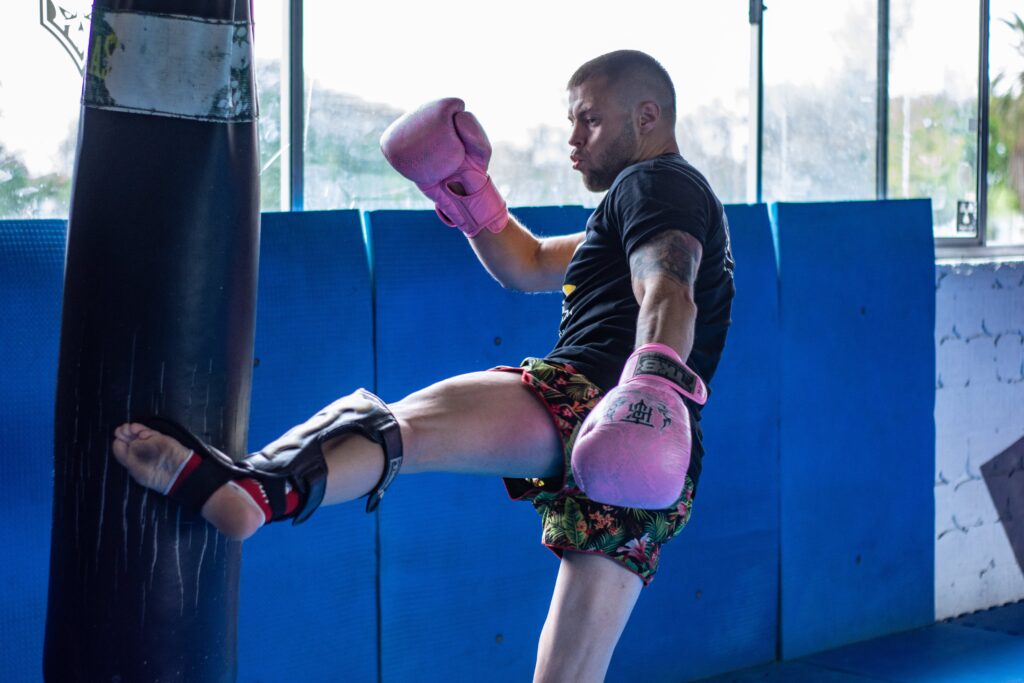Muay Thai oil, colloquially known as Thai oil, is a specialised liniment deeply ingrained in the world of martial arts, particularly within Muay Thai of course. It is a unique concoction of natural ingredients carefully blended to create a solution which can bring numbness to the area applied (ideal for treating injuries & painful areas without open wounds.)
This traditional liniment holds cultural significance, the scent is almost synonymous with Thai boxing as the smell of the liniment will likely hit you in the face each time you step near the ring at an event.
What is Muay Thai oil made from?
Muay Thai oil, also known as Thai oil, is a traditional liniment with a diverse range of formulations, and the specific ingredients can vary among different brands and styles.
While the exact recipes are often proprietary, here’s a general overview of the common ingredients and the typical process of making Muay Thai oil:
Common Ingredients
- Menthol: Provides a cooling sensation and helps soothe muscles.
- Methyl Salicylate: Known for its analgesic and anti-inflammatory properties, it helps alleviate pain and reduce swelling.
- Camphor: Has a cooling effect and is believed to improve blood circulation.
- Eucalyptus Oil: Known for its respiratory benefits, it can also contribute to the oil’s aromatic properties.
- Clove Oil: Offers analgesic and antimicrobial properties.
- Turpentine Oil: Traditionally used for its warming effect and potential muscle-relaxing properties.
- Cinnamon Oil: Adds a warming sensation and is believed to have anti-inflammatory benefits.
- Peppermint Oil: Contributes to the cooling sensation and has a refreshing scent.
- Ginger Oil: Known for its anti-inflammatory properties and ability to soothe sore muscles.
- Arnica Extract: Believed to have anti-inflammatory and pain-relieving effects.
General Manufacturing Process
- Selection of Ingredients: Manufacturers carefully choose each ingredient based on its therapeutic properties and traditional uses.
- Measuring and Mixing: Precise measurements of each ingredient are combined in specific proportions to achieve the desired balance.
- Heating and Infusion: The mixture is often heated to facilitate the infusion of the active components. This step helps blend the ingredients and enhance their effectiveness.
- Cooling and Settling: After heating, the mixture is allowed to cool and settle, ensuring that the ingredients are well incorporated.
- Bottling and Packaging: Once the liniment has reached the desired consistency, it is bottled and packaged for distribution. Some formulations may require a settling period before being ready for use.
Important Considerations when using Muay Thai Oil
- Traditional Knowledge: The recipes for Muay Thai oil often draw on centuries-old traditional knowledge passed down through generations.
- Branding and Variation: Different brands may have unique formulations, and variations in ingredients can result in liniments with distinct scents, textures, and effects.
- User Sensitivity: Users with allergies or sensitivities should carefully read the ingredient list and perform a patch test to ensure compatibility with their skin.
It’s essential to follow the specific instructions provided by the manufacturer for the application of Muay Thai oil.
Due to the potential for skin irritation, users should exercise caution and discontinue use if any adverse reactions occur.
Always consult with a healthcare professional if there are concerns about potential allergies or skin conditions.
The history of Muay Thai Oil
Tiger balm & Muay Thai Oils can find their origins in Thai herbal medicine, where an exclusive recipe had been safeguarded for generations, passed down discreetly among select Muay Thai gyms.
This closely held concoction, a well-kept secret within fighting circles, was a cherished gem known only to a privileged few. It wasn’t until the year 1963, during the reign of Pon Kingpetch, Thailand’s inaugural western-style boxing champion, that this enigmatic elixir transcended its status as an insider’s remedy to become a globally recognised treatment for fighters.
Pon Kingpetch, a devoted disciple of the gym owned by the visionary coach Thongthos Intratat, found himself guided by an exceptional mentor. Intratat, an aficionado of herbalism and alternative medicine, tirelessly delved into traditional Thai home remedies to support his team of fighters in their warm-ups and recovery from the rigors of intense training and frequent bouts.
Intratat’s breakthrough moment arrived when he observed that fighters massaged with his homemade Namman Muay oil displayed heightened resilience and reduced vulnerability to injuries after rigorous contests.
This revelation prompted Intratat to establish Devakam Apothecary Hall, his pharmaceutical venture, marking the inception of mass produced Muay Thai Oil.
In tandem with these developments, it’s noteworthy that the Thai army incorporated the use of Tiger Balm as part of their physical combat training, further underscoring the integration of traditional remedies into martial practices.
In homage to the monumental contributions of Pon Kingpetch and Thongthos Intratat, a statue was erected in Hua Hin, Southern Thailand. This statue symbolises their historical achievements and the enduring legacy of Muay Thai liniment, a product born from the fusion of traditional wisdom and modern application. Today, the liniment stands as a testament to the cultural heritage and efficacy of Thai martial arts remedies, echoing the time-honored traditions that have shaped its evolution.
How to apply Muay Thai Oil?
To apply Muay Thai oil, start by pouring on specific areas of your body, focusing on muscles and joints. Common areas include:
- Thighs
- Calves
- Shins
- Arms
- Shoulders
- Neck
- Back
Massage the oil into the skin in a circular motion if applying on an injury sustained during training or in a fight. Make sure not to use the oil on any open wounds. Allow the oil to absorb into your skin for a few minutes. This time can be utilised for deep breathing exercises to enhance relaxation.
Pre fight
Most fighters make use of Tiger Balm before entering the ring as it can increase a fighters pain threshold & resilience, although this depends on the individual.
Many fighters also believe it can also promote healing effects after the fight due to the increased blood flow to certain areas on the body.

Can Muay Thai Oil expire?
Muay Thai oil is typically composed of ethanol and natural enzymes, creating a formula designed to prevent the build-up of harmful bacteria. The ethanol in the oil serves as a natural disinfectant, contributing to its preservation. This combination makes Muay Thai oil resistant to bacterial contamination, ensuring a hygienic application.
Under optimal conditions, Muay Thai oil has a remarkable shelf life, and its effectiveness can be maintained almost indefinitely. The ethanol content and natural enzymes act as stabilizers, contributing to the liniment’s longevity. However, it’s essential to note that certain conditions can impact the effectiveness of Muay Thai oil.
One significant factor is exposure to sunlight, particularly when the oil is stored in an open container. Prolonged exposure to sunlight over many years may reduce the potency of the oil. Therefore, it is advisable to store Muay Thai oil in a cool, dry place, away from direct sunlight, to preserve its efficacy.
In summary, Muay Thai oil, with its ethanol and natural enzymes, has the inherent ability to resist bacterial growth, contributing to its long-lasting nature. While it can keep almost indefinitely, care should be taken to avoid prolonged exposure to sunlight, which may impact its effectiveness over time. Proper storage practices will help ensure that Muay Thai oil remains a reliable and effective liniment for an extended period.
Conclusion
Experiment with Muay Thai oil in training before you give yourself a shower with the stuff on fight day. Trust me, the last thing you need is to feel like the acid bath guy fro robocop before hopping in the ring. At best it will anger you enough to get and adrenaline boost, or it could just be a major distraction.
Should you use it? The proof is in the pudding really. I’d advise using it on injuries to promote healing or before a fight to help with resilience.


